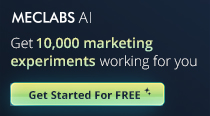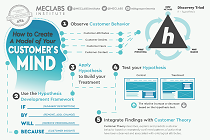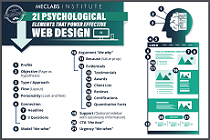
|
SUMMARY:
Marketing intern: “So how does it work exactly?” Overconfident (but ill-informed) marketer: “Oh, it’s this guy Al GoRhythm. He analyzes your audience and finds people just like them.” Do we marketers really understand how algorithms and other marketing technology work? The above exchange is tongue-in-cheek, of course, but just knowing something is algorithmically assembled or AI-driven is no guarantee that it will produce the best result. This thought ran through my mind as I saw the results from a recent experiment run by my colleague, Senior Marketing Manager Paul Cheney. Read on to learn how our own Paul Cheney drove down cost-per-action in a Facebook advertising campaign by relying on a more old-school targeting approach.
|
by Daniel Burstein, Senior Director, Content & Marketing, MarketingSherpa and MECLABS Institute
This article was originally published in the MarketingSherpa email newsletter.
“We try to get the audience right first before we tweak the message. Part of MECLABS’ strength as an organization is getting the message in the zone. What we don’t have, in this case, is enough of the right people viewing the message. So we’re prioritizing audience testing first. And this was one question in our design of experiments that we’re currently testing to optimize our Facebook audiences,” Cheney said.
The conversion goal
Paul’s test aimed at getting the word out about the micro course in mobile marketing from MECLABS Institute (parent research organization of MarketingSherpa).
The copy read …
Optimize your Mobile Funnels: 25 years of research distilled into 5 quick sessions
Free Mobile Micro Course
5 classes, 12 minutes each

Treatment #1: Lookalike audience
For the first treatment, Paul chose to distribute it to a “lookalike” audience.
If you’re unfamiliar with the concept, this is a way to target your digital advertising to a group of people who are similar to a known quantity — for example, current customers of your brand, email subscribers, social media followers.
For Facebook, specifically, you choose your known quantity and the size of the audience you want to reach, and the social network’s algorithm does all the work for you.
Paul used MECLABS email newsletter subscribers as his known quantity.
“I chose newsletter subscribers instead of people who have already converted on the mobile micro-course landing page because a bigger sample size should create a more accurate lookalike audience, and the MECLABS newsletters subscribers should have the same motivations,” Paul said.
Treatment #2: Interest-based audience
The second treatment used a more traditional approach, targeting an audience for the ad based on potential customers’ interests.
Flint McGlaughlin, Managing Director and CEO, MECLABS Institute, built the keyword list for the interest-based targeting with feedback from marketers like you in an interactive, live session — Subscription Marketing Discoveries: 26 marketing experiments to help you boost recurring revenue.
Many of the recommendations from the audience were too specific for the Facebook platform, so Paul could only use “mobile marketing” and “A/B testing” from the audience. So he added in more keywords and did a Google search for brands related to MarketingSherpa and MarketingExperiments to find brands big enough to have Facebook audiences but small enough to be in our niche.
Keywords:
Related Brands:
Results
The lookalike audience had a cost-per-action (CPA) of $2.50 while the interest-based audience had a CPA of $1.49.
So the audience we assembled “the old-fashioned way” cost 40% less per action than the lookalike audience.
Stay curious
I don’t want to overstate the impact of this experiment. It is, after all, just one experiment, and by no means an indictment of lookalike campaigns.
“MECLABS email newsletter has a broad mix of demographics from business leaders to academics, and that might have impacted the performance of the lookalike campaign. We may do better with the smaller sample of previous converts, and that may be a subject for a future test,” Paul said.
Lookalike campaigns can be a very powerful tool to help get your message out to the right audience.
However, I wanted to share this experiment with you today as a way to remind you to stay curious. It’s all too easy to blindly outsource some of our responsibilities (like in this case, audience selection) to technology. It’s worth testing to discover how well that technology works against other methods, or even how you can tweak the settings of that technology.
After all, you the marketer should always drive the ship and use technology only as one tool in your toolbox. If you are overly reliant on algorithms and AI, you might find yourself on the outside of your marketing department looking in with your platform telling you, “I’m sorry, Dave. I’m afraid I can’t do that.”
“Don’t ever run a Facebook campaign without an A/B test on the front end. Once you’re in the zone, there is no way to know what works for your audience until you test,” Paul advised.
You can follow Daniel Burstein, Senior Director, Content & Marketing, MarketingSherpa and MECLABS Institute, on Twitter @DanielBurstein.
Related Resources
Online Testing certification course – On-demand training from MECLABS Institute
Get Better Business Results With a Skillfully Applied Customer-first Marketing Strategy

The customer-first approach of MarketingSherpa’s agency services can help you build the most effective strategy to serve customers and improve results, and then implement it across every customer touchpoint.
Get More Info >MECLABS AI

Get headlines, value prop, competitive analysis, and more.
Use the AI for FREE (for now) >Marketer Vs Machine

Marketer Vs Machine: We need to train the marketer to train the machine.
Watch Now >Live, Interactive Event

Join Flint McGlaughlin for Design Your Offer on May 22nd at 1 pm ET. You’ll learn proven strategies that drive real business results.
Get Your Scholarship >Free Marketing Course

Become a Marketer-Philosopher: Create and optimize high-converting webpages (with this free online marketing course)
See Course >Project and Ideas Pitch Template

A free template to help you win approval for your proposed projects and campaigns
Get the Template >Six Quick CTA checklists

These CTA checklists are specifically designed for your team — something practical to hold up against your CTAs to help the time-pressed marketer quickly consider the customer psychology of your “asks” and how you can improve them.
Get the Checklists >Infographic: How to Create a Model of Your Customer’s Mind

You need a repeatable methodology focused on building your organization’s customer wisdom throughout your campaigns and websites. This infographic can get you started.
Get the Infographic >Infographic: 21 Psychological Elements that Power Effective Web Design

To build an effective page from scratch, you need to begin with the psychology of your customer. This infographic can get you started.
Get the Infographic >Receive the latest case studies and data on email, lead gen, and social media along with MarketingSherpa updates and promotions.